Navigation
Environmental Action in Seattle for A Sustainable, Healthier Future
Climate Protection Initiative: Reducing global warming pollution and improving air quality
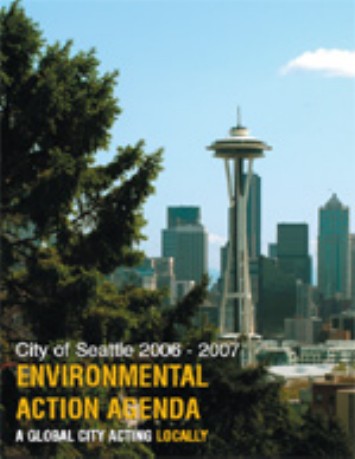 |
Seattle 2006-2007 Environmental Action Agenda:
A Global City Acting Locally
Climate Protection Initiative:
Reducing global warming pollution and improving air quality
Recent Accomplishments:
- Launched Climate Protection Initiative
- More than 275 mayors signed onto US Mayors Climate Protection Agreement
- Released report and recommendations of Green Ribbon Commission and organized community input sessions
- Seattle City Light achieved zero net emissions of global warming pollution
- Reduced the City fleet’s use of fossil fuels by 12% compared to the 1999 baseline; increased use of biodiesel in City fleet 4.5 times over 2003 levels
- Completed retrofitting the City's fleet of heavy duty diesel trucks with state of the art emission control equipment
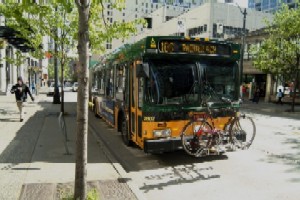 |
Key Next Steps:
- Complete the Seattle Climate Action Plan, a detailed strategy— based on Green Ribbon Commission recommendations—for reducing the city's global warming pollution and helping Seattle-area businesses and residents lower their greenhouse gas emissions
- Launch the Seattle Climate Partnership, a voluntary climate protection pact among Seattle-area employers
- Complete Chief Sealth Trail in southeast Seattle, and a comprehensive Bicycle Master Plan that enhances bicycling opportunities and improves connections between urban villages and centers
- Continue to meet City Light’s “zero net emissions” goal through conservation, renewable energy, and offset projects
- Continue to increase alternative fuel and advance technology vehicles in the City fleet
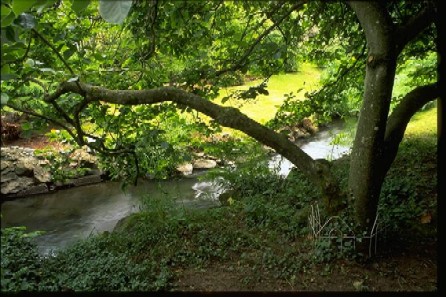 |
Green Seattle Initiative
Restoring the urban forest, increasing open space and greening the built environment
Recent Accomplishments:
- Initiated restoration on more than 75 acres of forested parklands through the Green Seattle Partnership
- Created six new community gardens, focusing on underserved areas and bringing City-wide total to 70
- Planted more than 4,000 new trees on major streets and in neighborhoods
- Acquired more than 30 acres to preserve wild habitat, increase green space, and create eight new parks in underserved areas
- Reduced pesticide use in Parks general operations by 80% from the baseline
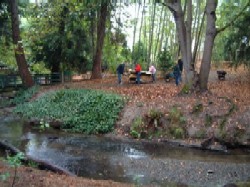 |
Key Next Steps:
- Initiate restoration on 85 additional acres of forested parklands and
recruit and manage 75,000 volunteer hours through the Green Seattle
Partnership
- Adopt an Urban Forest Management Plan, including goals for increasing tree cover
- Increase vegetation, including tree preservation and planting, on private property through education, incentives and regulations such as creating flexible landscaping requirements for development projects
- Increase tree planting on City property and improve maintenance of City-owned street trees
- Increase open space in fast-growing neighborhoods by implementing new open space impact fees
- Build green roofs on two City buildings and monitor four green roofs to inform policy and program development
Restore Our Waters
Protecting and improving water quality and aquatic habitat
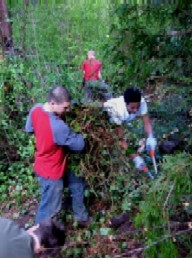 |
Recent Accomplishments:
- Launched Restore Our Waters Initiative outlining priority actions for water quality and aquatic habitat improvements
- 42 blocks of natural drainage systems installed
- Created new grant program to provide residents and businesses with matching funds for aquatic habitat restoration (five awards totaled $300,000)
- Completed two shoreline restorations on Lake Washington, improved water quality in Green Lake and conducted a water quality study in the Duwamish at Norfolk Basin
- Adopted a stronger Environmentally Critical Areas Ordinance to better protect wetlands, creek corridors and shoreline areas
Key Next Steps:
- Revise drainage code and rates to provide incentives for property owners to manage stormwater on-site with green roofs, rain gardens, rain barrels and cisterns
- Improve shoreline and aquatic habitat in the Ship Canal and Lake Union through a program that directs developers’ mitigation fees toward high-priority restoration sites
- Install 18 new blocks of natural drainage systems
- Systematically identify and implement opportunities to improve water quality and aquatic habitat as part of the City’s capital improvement projects
- Begin comprehensive Shoreline Master Program update
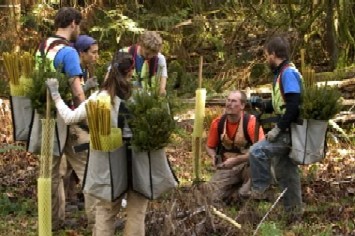 |
| V olunteers planting trees in the Cedar River Watershed |
Healthy People & Communities
Creating healthy, livable urban centers, promoting sustainable practices and improving environmental justice
Recent Accomplishments:
- Adopted downtown zoning changes to reduce sprawl and encourage transit-friendly development, affordable housing and green building
- Continued healthy redevelopment of Northgate, South Lake Union, South Downtown and other urban centers
- Produced “Green Seattle Guide” to inform and inspire individual action
- Completed seven civic green building projects, bringing City total to 13
- Strengthened recycling program, including increasing food and yard waste composting services
Key Next Steps:
- Complete the Livable South Downtown Plan to increase housing and improve walkability, open space and neighborhood vitality
- Complete redevelopment plan for the Central Waterfront to include a healthy network of green spaces, walking and biking trails and shoreline access points
- Strengthen City’s Green Building Program by increasing outreach, technical assistance and incentives to developers; launch sustainable development resource center
- Improve indoor air quality in affordable housing projects through enhanced construction standards and targeted outreach to building owners and inhabitants
- Reduce waste and feed hungry people by strengthening programs that redirect edible food to people in need
Green Seattle Initiative – Keeping the Emerald City Green
Seattle is rapidly losing its green. In 1972, trees covered about 40% of the city. Since then, tree cover has declined to about 18%. We are witnessing the death of our precious forested parklands as they have aged and invasive plants like ivy have choked out the next generation of trees.
This loss is so much more than aesthetic. Trees contribute value to Seattle by absorbing storm water and improving air and water quality as well as increasing our property values. Trees are part of the fabric of our quality of life in Seattle, bringing nature into our urban landscape.
The Urban Forest Management Plan, our first ever comprehensive plan for managing all of the trees across the city - public and private, will be ready for public comment this fall.
This plan establishes aggressive canopy cover goals and creates a framework for actions that will improve the number and condition of the city’s trees. Community comments this fall will help shape the plan and our path ahead.
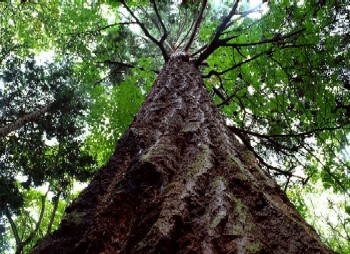 |
While we are moving the plan forward for adoption later this year, the City will take the following steps toward the overarching goal of improving the condition of the city’s urban forest:
- The Green Seattle Partnership with the Cascade Land Conservancy is ramping up efforts to restore 2500 acres of degraded forested parkland by 2025 by removing invasive species and replanting. The program’s 20-year plan is ambitious and can only be achieved as a partnership with the city’s residents. The investments made today will serve generations of Seattleites into the future.
- Private property makes up about three quarters of Seattle, meaning that many of our best opportunities for preserving and planting trees are in our yards and in our business districts and on our campuses. This fall, the Mayor will launch a major effort to encourage residents to plant more trees.
- The City will convene an Emerald City Task Force of developers, urban designers, builders, and residents to develop recommendations for new incentives and regulations to protect existing trees and encourage tree planting. Together we can keep the Emerald City green.
“Seattleites define themselves as ‘green’ not only by taking a bus to work, buying a fuel-efficient car or taking a canvas bag to the market – but by the very choice they’ve made to live and work here. While bounded by the mountains and water, Seattle is most of all a city of trees and green spaces.” – Mayor Nickels
Thanks to the Mayor's Urban Sustainability Advisory Panel who provided their support and guidance
Stella Chao, Executive Director International District Housing Alliance
Cynthia Figge, Partner EKOS International
Wayne Grotheer, Director Health, Environment & Risk Services Port of Seattle
Dennis McLerran, Executive Director Puget Sound Clean Air Agency
Rodney Proctor, Director Environmental Health & Safety Weyerhaeuser
Ken Bounds, Superintendent Seattle Parks and Recreation Jorge Carrasco, Superintendent Seattle City Light
Charlie Cunniff, Executive Director Environmental Coalition of South Seattle
KC Golden, Project Director Climate Solutions
David Levinger, President & Executive Director Feet First
Ben Packard, Director Environmental Affairs Starbucks Coffee Company
Scott Rusch, Vice President Facilities and Operations Fred Hutchinson Cancer Research Center
Chuck Clarke, Director Seattle Public Utilities
Alan Durning, Executive Director Sightline Institute
Bert Gregory, Principal Mithun
Michael McGinn Sierra Club - Cascade Chapter
Margaret Pageler Ex Officio Member
Sharon Sutton, Professor Center for Environment, Education & Design
Grace Crunican, Director Seattle Transportation
Diane Sugimura, Director Seattle Department of Planning & Development
 |
Report and Photographs thanks to the City of Seattle
Office of the Mayor
Office of Sustainability and Environment
(206) 684-4000 (206) 615-0817
Search
Latest articles
Agriculture
- World Water Week: Healthy ecosystems essential to human health: from coronavirus to malnutrition Online session Wednesday 24 August 17:00-18:20
- World Water Week: Healthy ecosystems essential to human health: from coronavirus to malnutrition Online session Wednesday 24 August 17:00-18:20
Air Pollution
- "Water and Sanitation-Related Diseases and the Changing Environment: Challenges, Interventions, and Preventive Measures" Volume 2 Is Now Available
- Global Innovation Exchange Co-Created by Horizon International, USAID, Bill and Melinda Gates Foundation and Others
Biodiversity
- It is time for international mobilization against climate change
- World Water Week: Healthy ecosystems essential to human health: from coronavirus to malnutrition Online session Wednesday 24 August 17:00-18:20
Desertification
- World Water Week: Healthy ecosystems essential to human health: from coronavirus to malnutrition Online session Wednesday 24 August 17:00-18:20
- UN Food Systems Summit Receives Over 1,200 Ideas to Help Meet Sustainable Development Goals
Endangered Species
- Mangrove Action Project Collaborates to Restore and Preserve Mangrove Ecosystems
- Coral Research in Palau offers a “Glimmer of Hope”
Energy
- Global Innovation Exchange Co-Created by Horizon International, USAID, Bill and Melinda Gates Foundation and Others
- Wildlife Preservation in Southeast Nova Scotia
Exhibits
- Global Innovation Exchange Co-Created by Horizon International, USAID, Bill and Melinda Gates Foundation and Others
- Coral Reefs
Forests
- NASA Satellites Reveal Major Shifts in Global Freshwater Updated June 2020
- Global Innovation Exchange Co-Created by Horizon International, USAID, Bill and Melinda Gates Foundation and Others
Global Climate Change
- It is time for international mobilization against climate change
- It is time for international mobilization against climate change
Global Health
- World Water Week: Healthy ecosystems essential to human health: from coronavirus to malnutrition Online session Wednesday 24 August 17:00-18:20
- More than 400 schoolgirls, family and teachers rescued from Afghanistan by small coalition
Industry
- "Water and Sanitation-Related Diseases and the Changing Environment: Challenges, Interventions, and Preventive Measures" Volume 2 Is Now Available
- Global Innovation Exchange Co-Created by Horizon International, USAID, Bill and Melinda Gates Foundation and Others
Natural Disaster Relief
- STOP ATTACKS ON HEALTH CARE IN UKRAINE
- Global Innovation Exchange Co-Created by Horizon International, USAID, Bill and Melinda Gates Foundation and Others
News and Special Reports
- World Water Week: Healthy ecosystems essential to human health: from coronavirus to malnutrition Online session Wednesday 24 August 17:00-18:20
- STOP ATTACKS ON HEALTH CARE IN UKRAINE
Oceans, Coral Reefs
- World Water Week: Healthy ecosystems essential to human health: from coronavirus to malnutrition Online session Wednesday 24 August 17:00-18:20
- Mangrove Action Project Collaborates to Restore and Preserve Mangrove Ecosystems
Pollution
- Zakaria Ouedraogo of Burkina Faso Produces Film “Nzoue Fiyen: Water Not Drinkable”
- "Water and Sanitation-Related Diseases and the Changing Environment: Challenges, Interventions, and Preventive Measures" Volume 2 Is Now Available
Population
- "Water and Sanitation-Related Diseases and the Changing Environment: Challenges, Interventions, and Preventive Measures" Volume 2 Is Now Available
- "Water and Sanitation-Related Diseases and the Changing Environment: Challenges, Interventions, and Preventive Measures" Volume 2 Is Now Available
Public Health
- Honouring the visionary behind India’s sanitation revolution
- Honouring the visionary behind India’s sanitation revolution
Rivers
- World Water Week: Healthy ecosystems essential to human health: from coronavirus to malnutrition Online session Wednesday 24 August 17:00-18:20
- Mangrove Action Project Collaborates to Restore and Preserve Mangrove Ecosystems
Sanitation
- Honouring the visionary behind India’s sanitation revolution
- Honouring the visionary behind India’s sanitation revolution
Toxic Chemicals
- "Water and Sanitation-Related Diseases and the Changing Environment: Challenges, Interventions, and Preventive Measures" Volume 2 Is Now Available
- Actions to Prevent Polluted Drinking Water in the United States
Transportation
- "Water and Sanitation-Related Diseases and the Changing Environment: Challenges, Interventions, and Preventive Measures" Volume 2 Is Now Available
- Urbanization Provides Opportunities for Transition to a Green Economy, Says New Report
Waste Management
- Honouring the visionary behind India’s sanitation revolution
- Honouring the visionary behind India’s sanitation revolution
Water
- Honouring the visionary behind India’s sanitation revolution
- Honouring the visionary behind India’s sanitation revolution
Water and Sanitation
- Honouring the visionary behind India’s sanitation revolution
- Honouring the visionary behind India’s sanitation revolution

